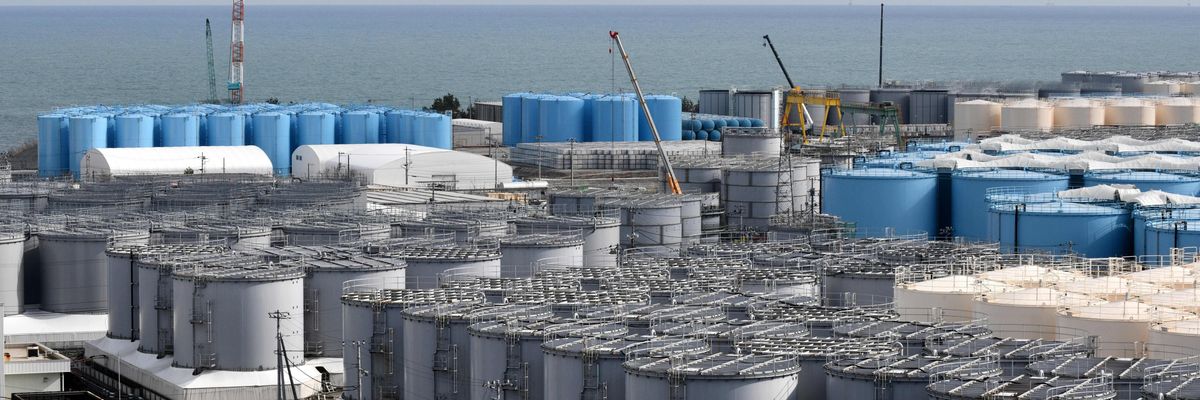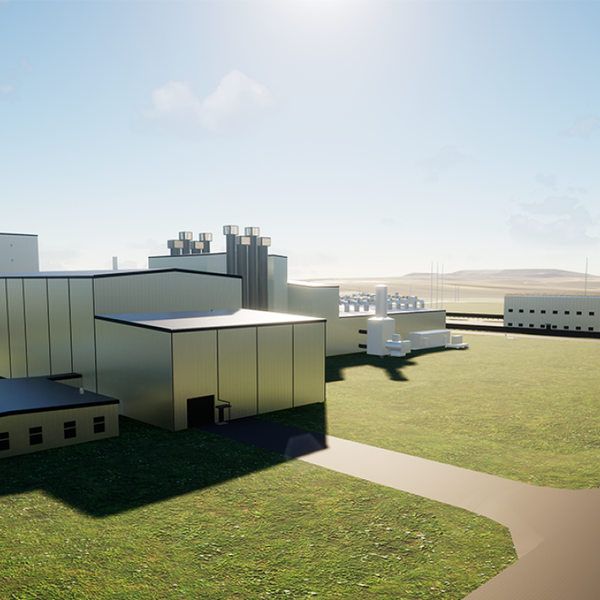
This picture taken on February 3, 2020 shows storage tanks for contaminated water at the Tokyo Electric Power Company's (TEPCO) Fukushima Daiichi nuclear power plant in Okuma, Fukushima prefecture in Japan.
Despite Warnings, IAEA Approves Japan Release Plan for Contaminated Fukushima Water
"Piping water into the sea is an outrage. The sea is not a garbage dump," said one local fisherman earlier this year.
Despite years of protest and warnings from environmentalists, the United Nation's nuclear watchdog on Tuesday approved a plan by Japan to release tens of millions of gallons of water from the destroyed Fukushima nuclear power plant into the ocean.
The massive storage of radioactive water has been ongoing since the 2011 tsunami disaster triggered a meltdown of the plant, but the International Atomic Energy Agency (IAEA) said the plan orchestrated by the Japanese government and TEPCO, the plant operator, meets safety standards.
Based on a "comprehensive" two-year assessment, "the IAEA has concluded that the approach and activities to the discharge of ALPS treated water taken by Japan are consistent with relevant international safety standards,” the agency's director general Rafael Mariano Grossi said in the foreword of a new report released alongside the decision.
“Furthermore," Grossi continued, "the IAEA notes the controlled, gradual discharges of the treated water to the sea, as currently planned and assessed by TEPCO, would have a negligible radiological impact on people and the environment."
According to the IAEA statement:
The water stored at the FDNPS has been treated through an Advanced Liquid Processing System (ALPS) to remove almost all radioactivity, aside from tritium. Before discharging, Japan will dilute the water to bring the tritium to below regulatory standards.
Despite assurances, nuclear experts have said that concerns about tritium cannot be overstated. In 2020, Greenpeace International released a report warning that the contaminated water risks "potential damage to human DNA" and questioned the government and TEPCO's push for the release.
As Bloomberg notes, "an assessment of the discharge facility by a domestic nuclear regulator is still required before a timeline is finalized to begin releasing the water—equivalent in volume to about 500 Olympic-size swimming pools. Government officials have indicated the discharges, which could take decades, would begin during the summer."
The IAEA's assessment flies in the face of scientific warnings, environmentalists, and local residents who have argued that dumping the water into the Pacific Ocean should be "'simply Inconceivable."
"Piping water into the sea is an outrage. The sea is not a garbage dump," 71-year-old Haruo Ono, who has been fishing off the coast of Fukushima his entire life, told CBS News earlier this year after the IAEA released a preliminary assessment of the plan. "The company says it's safe, but the consequences could catch up with us 50 years down the road."
An Urgent Message From Our Co-Founder
Dear Common Dreams reader, The U.S. is on a fast track to authoritarianism like nothing I've ever seen. Meanwhile, corporate news outlets are utterly capitulating to Trump, twisting their coverage to avoid drawing his ire while lining up to stuff cash in his pockets. That's why I believe that Common Dreams is doing the best and most consequential reporting that we've ever done. Our small but mighty team is a progressive reporting powerhouse, covering the news every day that the corporate media never will. Our mission has always been simple: To inform. To inspire. And to ignite change for the common good. Now here's the key piece that I want all our readers to understand: None of this would be possible without your financial support. That's not just some fundraising cliche. It's the absolute and literal truth. We don't accept corporate advertising and never will. We don't have a paywall because we don't think people should be blocked from critical news based on their ability to pay. Everything we do is funded by the donations of readers like you. Will you donate now to help power the nonprofit, independent reporting of Common Dreams? Thank you for being a vital member of our community. Together, we can keep independent journalism alive when it’s needed most. - Craig Brown, Co-founder |
Despite years of protest and warnings from environmentalists, the United Nation's nuclear watchdog on Tuesday approved a plan by Japan to release tens of millions of gallons of water from the destroyed Fukushima nuclear power plant into the ocean.
The massive storage of radioactive water has been ongoing since the 2011 tsunami disaster triggered a meltdown of the plant, but the International Atomic Energy Agency (IAEA) said the plan orchestrated by the Japanese government and TEPCO, the plant operator, meets safety standards.
Based on a "comprehensive" two-year assessment, "the IAEA has concluded that the approach and activities to the discharge of ALPS treated water taken by Japan are consistent with relevant international safety standards,” the agency's director general Rafael Mariano Grossi said in the foreword of a new report released alongside the decision.
“Furthermore," Grossi continued, "the IAEA notes the controlled, gradual discharges of the treated water to the sea, as currently planned and assessed by TEPCO, would have a negligible radiological impact on people and the environment."
According to the IAEA statement:
The water stored at the FDNPS has been treated through an Advanced Liquid Processing System (ALPS) to remove almost all radioactivity, aside from tritium. Before discharging, Japan will dilute the water to bring the tritium to below regulatory standards.
Despite assurances, nuclear experts have said that concerns about tritium cannot be overstated. In 2020, Greenpeace International released a report warning that the contaminated water risks "potential damage to human DNA" and questioned the government and TEPCO's push for the release.
As Bloomberg notes, "an assessment of the discharge facility by a domestic nuclear regulator is still required before a timeline is finalized to begin releasing the water—equivalent in volume to about 500 Olympic-size swimming pools. Government officials have indicated the discharges, which could take decades, would begin during the summer."
The IAEA's assessment flies in the face of scientific warnings, environmentalists, and local residents who have argued that dumping the water into the Pacific Ocean should be "'simply Inconceivable."
"Piping water into the sea is an outrage. The sea is not a garbage dump," 71-year-old Haruo Ono, who has been fishing off the coast of Fukushima his entire life, told CBS News earlier this year after the IAEA released a preliminary assessment of the plan. "The company says it's safe, but the consequences could catch up with us 50 years down the road."
Despite years of protest and warnings from environmentalists, the United Nation's nuclear watchdog on Tuesday approved a plan by Japan to release tens of millions of gallons of water from the destroyed Fukushima nuclear power plant into the ocean.
The massive storage of radioactive water has been ongoing since the 2011 tsunami disaster triggered a meltdown of the plant, but the International Atomic Energy Agency (IAEA) said the plan orchestrated by the Japanese government and TEPCO, the plant operator, meets safety standards.
Based on a "comprehensive" two-year assessment, "the IAEA has concluded that the approach and activities to the discharge of ALPS treated water taken by Japan are consistent with relevant international safety standards,” the agency's director general Rafael Mariano Grossi said in the foreword of a new report released alongside the decision.
“Furthermore," Grossi continued, "the IAEA notes the controlled, gradual discharges of the treated water to the sea, as currently planned and assessed by TEPCO, would have a negligible radiological impact on people and the environment."
According to the IAEA statement:
The water stored at the FDNPS has been treated through an Advanced Liquid Processing System (ALPS) to remove almost all radioactivity, aside from tritium. Before discharging, Japan will dilute the water to bring the tritium to below regulatory standards.
Despite assurances, nuclear experts have said that concerns about tritium cannot be overstated. In 2020, Greenpeace International released a report warning that the contaminated water risks "potential damage to human DNA" and questioned the government and TEPCO's push for the release.
As Bloomberg notes, "an assessment of the discharge facility by a domestic nuclear regulator is still required before a timeline is finalized to begin releasing the water—equivalent in volume to about 500 Olympic-size swimming pools. Government officials have indicated the discharges, which could take decades, would begin during the summer."
The IAEA's assessment flies in the face of scientific warnings, environmentalists, and local residents who have argued that dumping the water into the Pacific Ocean should be "'simply Inconceivable."
"Piping water into the sea is an outrage. The sea is not a garbage dump," 71-year-old Haruo Ono, who has been fishing off the coast of Fukushima his entire life, told CBS News earlier this year after the IAEA released a preliminary assessment of the plan. "The company says it's safe, but the consequences could catch up with us 50 years down the road."

